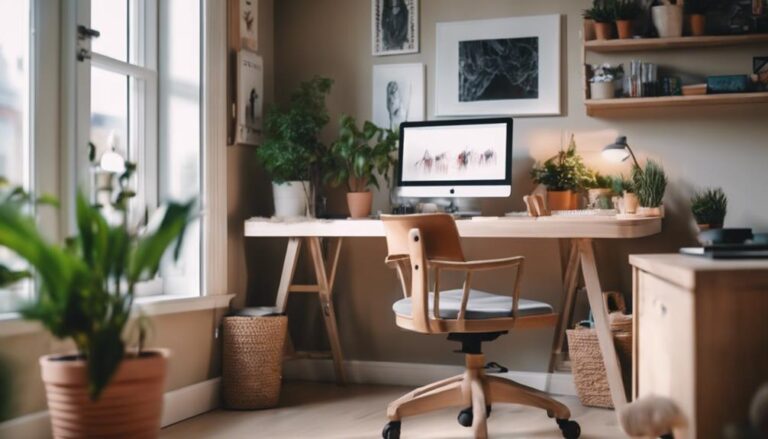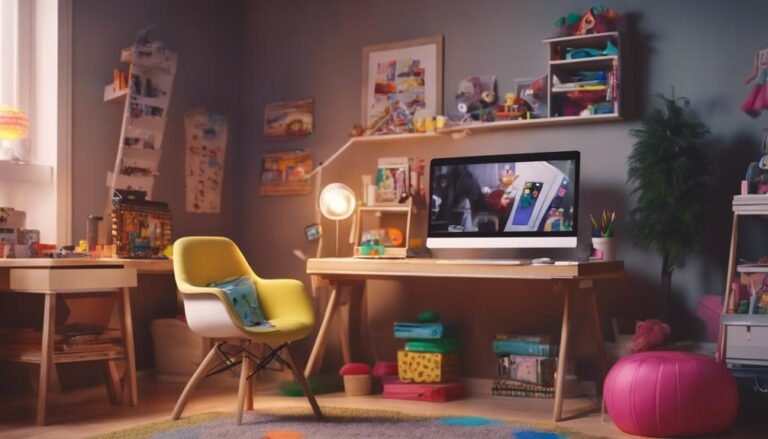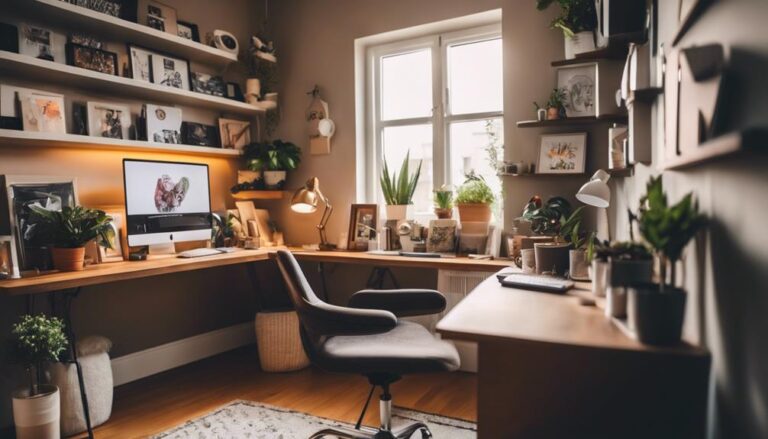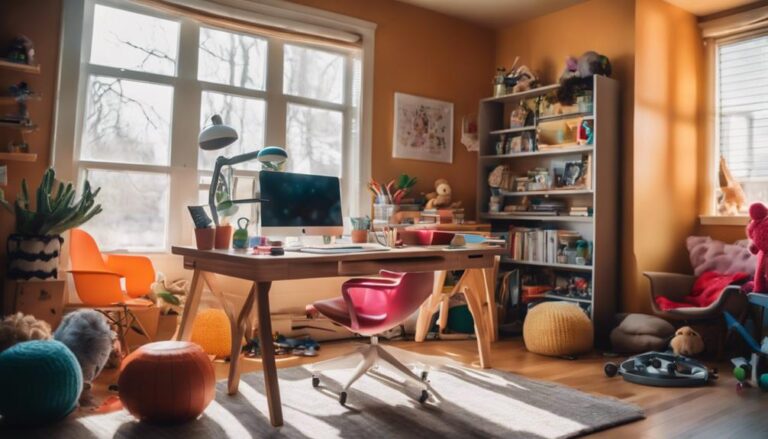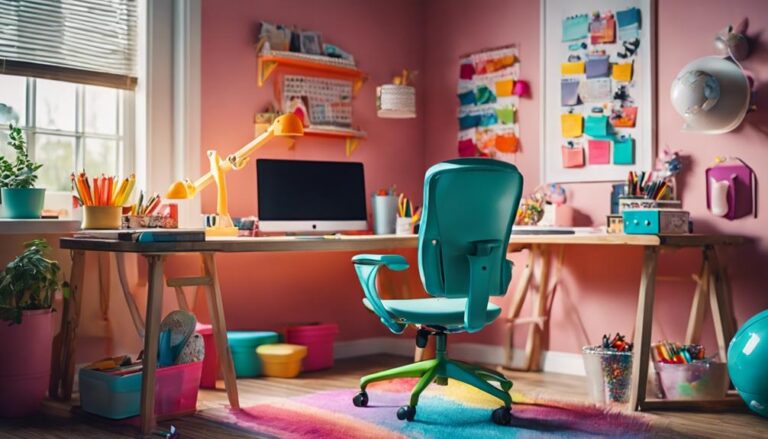Creating a kid-safe workspace is essential. First, choose a well-lit, distraction-free area. Use furniture to define physical boundaries. Always childproof the space and provide ergonomic furniture to guarantee comfort. Opt for child-friendly tools with safety features and organize the area efficiently with designated spots for everything. Offer a mix of age-appropriate activities to keep kids engaged but safe. Supervise and monitor regularly, reinforcing safety protocols to build a secure environment. If you're keen to dive deeper, there's a lot more to discuss on this important topic!
Key Takeaways
- Ensure the workspace is well-lit and free from distractions to maintain focus.
- Use furniture and visual cues to establish clear physical boundaries within the space.
- Childproof the area by securing sharp objects and covering electrical outlets.
- Provide ergonomic furniture suited to children's sizes to promote comfort and safety.
- Organize the workspace with designated spots for materials to keep it tidy and efficient.
Choosing the Right Space
Selecting the perfect space for a kid-safe workspace is essential for fostering focus and productivity. When finding the perfect spot, I prioritize well-lit areas that are comfortable and away from distractions like TV and toys. This helps create a conducive environment for both work and creativity.
The key is to avoid any sense of confinement, ensuring the space feels open and inviting. I carefully choose a location that minimizes disruptions, setting the stage for a harmonious balance between work and play.
Establishing Boundaries
How can we create a kid-safe workspace that balances work and play?
Establishing clear boundaries is vital. By creating physical zones using furniture, we can effectively define separate areas for work and play.
Symbolic boundaries, such as colorful tape or rugs, visually demarcate these spaces, helping to maintain focus. A designated kid-friendly corner with engaging activities guarantees children remain within sight while staying entertained and safe.
Clearly communicating these boundaries to children is necessary, so they understand where play ends and work begins. This approach not only fosters a harmonious environment but also allows for innovation in workspace design, ensuring that both productivity and child safety are prioritized.
Safety and Ergonomics
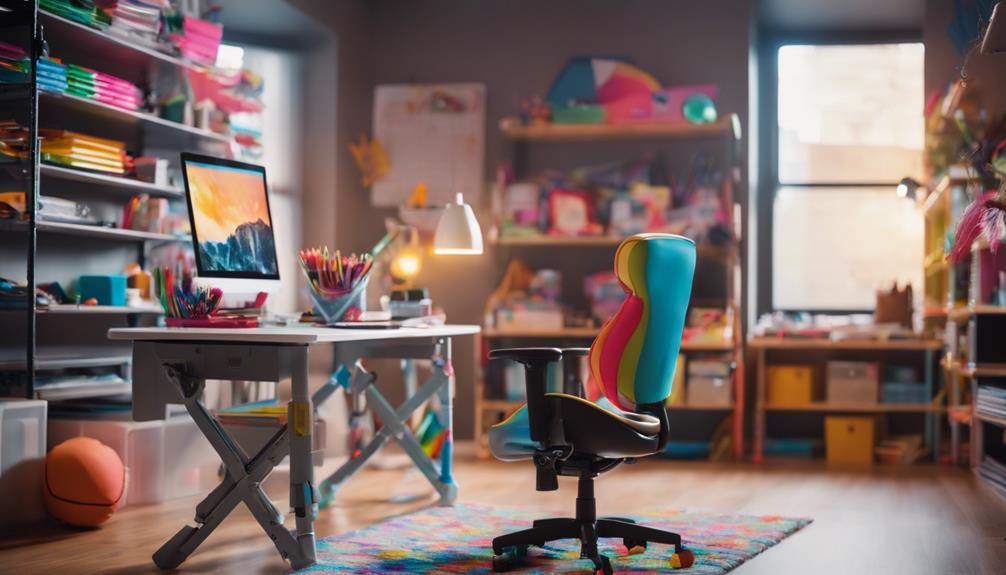
Ensuring a kid-safe workspace requires diligent attention to both safety and ergonomics. I always start by childproofing the area: securing cords, covering outlets, and selecting furniture with rounded corners to prevent accidents.
For ergonomic excellence, I introduce child-sized furniture like tables and chairs to promote proper posture and comfort. Creating a cozy space with bean bags or floor mats enhances the overall environment, making it inviting and functional.
For adults, supportive chairs and desks are essential to prevent discomfort and boost productivity. Clear boundaries within the workspace, designating areas for work and play, foster a harmonious setting.
Proper Equipment and Tools
When setting up a kid-safe workspace, I make sure to choose equipment and tools that are specifically designed to be safe and appropriate for children's use. Child-friendly tools with safety features, like automatic shut-off mechanisms and guards, are vital to prevent accidents.
Teaching kids how to properly use these tools and supervising them closely during activities is essential. I also prioritize storing sharp tools out of reach in secure containers to avoid unauthorized access.
Investing in child-sized tools or kits designed for young DIY enthusiasts can promote safe and engaging activities. By focusing on these details, I guarantee that the workspace isn't just safe but also fosters creativity and innovation for kids.
Organizing the Workspace
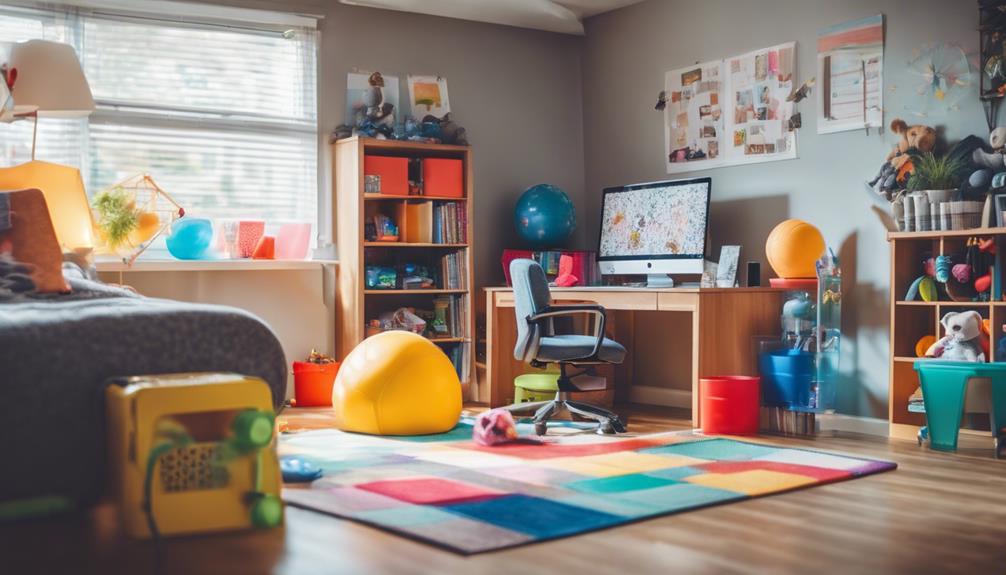
To create a productive and kid-safe workspace, I meticulously organize every item, guaranteeing everything has its designated spot. By utilizing organizational tools like folders and pencil cups, I keep the area clutter-free and efficient.
Designating specific spots for each item not only optimizes storage within compact spaces but also helps in creating an environment conducive to focus. I manage supplies effectively to prevent distractions, making sure essential items like pens, pencils, and erasers are always accessible.
Furnishing the desk with age-appropriate tools ensures kids can tackle their homework tasks efficiently. This meticulous approach to organization fosters a safe and innovative atmosphere where children can thrive in their studies.
Kid-Friendly Activities
Engaging children in stimulating activities is essential for fostering both their creativity and cognitive development in a kid-safe workspace. To keep kids engaged, I recommend incorporating age-appropriate puzzles and building blocks. These activities not only challenge their minds but also enhance problem-solving skills.
Setting up an art station with crayons, paper, and markers encourages creative expression and keeps kids' imaginations alive. Interactive educational toys offer a fun way for children to learn while playing.
Additionally, providing a mix of storybooks and educational books promotes a love for reading and helps keep kids' minds active and curious. By selecting these activities, we create an innovative environment that supports both learning and play.
Supervision and Monitoring
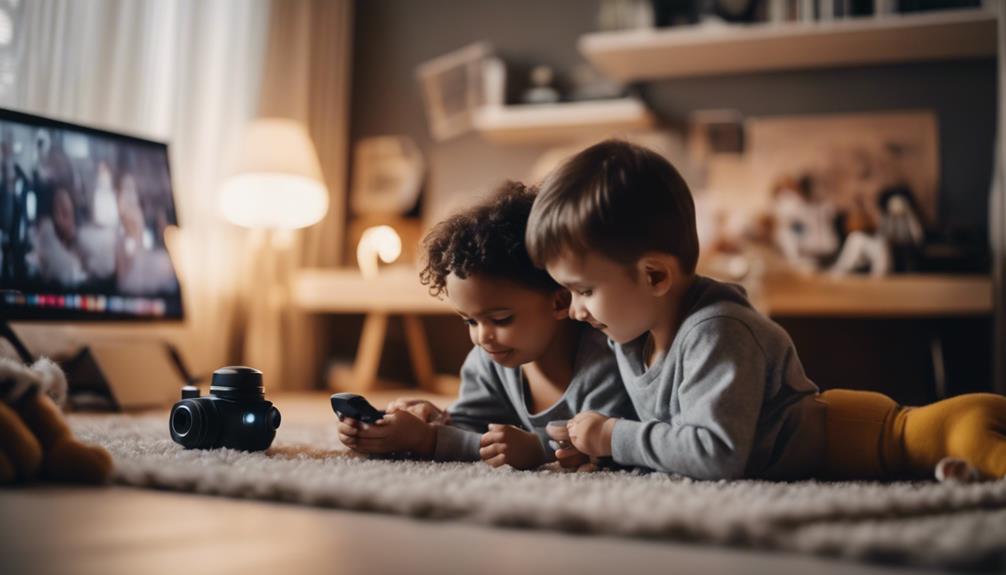
While fostering creativity and learning through engaging activities is essential, ensuring constant supervision and monitoring is equally vital to maintain a kid-safe workspace. I've found that proactive monitoring prevents children from accessing hazardous areas or equipment, ensuring their safety.
Supervision also guides them in proper behavior, helping them avoid interfering with work tasks. Regular monitoring means I can intervene quickly in emergencies or unsafe situations.
To effectively supervise and monitor:
- Establish Clear Guidelines: Collaborate with both parents and employers to set supervision standards.
- Designate Safe Areas: Mark specific zones where children can freely engage.
- Use Technology: Implement cameras or monitoring apps for enhanced oversight.
Reinforcing Safety Protocols
To guarantee our workspaces are safe for kids, we must prioritize clear safety guidelines, regular safety training, and heightened awareness of emergency procedures.
I can't stress enough how these proactive measures can greatly reduce the risk of accidents.
Clear Safety Guidelines
Clearly outlining rules and guidelines for children in the workspace is essential to reinforcing safety protocols and guaranteeing everyone stays safe. By fostering open communication, we can make certain that both children and employees understand and adhere to these guidelines.
Here are some critical points to take into account:
- Emergency Procedures: Explain and practice emergency steps so everyone knows what to do in case of an incident.
- Safety Equipment: Provide detailed instructions on how to use safety gear, ensuring children are comfortable and knowledgeable.
- Regular Reviews: Continually update and review safety protocols to address new risks and maintain a secure environment.
Regular Safety Training
Regular safety training is indispensable for ensuring that children grasp and consistently follow workplace safety protocols. By incorporating regular safety training, we can instill a deep understanding and adherence to these critical rules.
According to the American Academy of Pediatrics, consistent safety education is key to preventing accidents. Studies show that proactive measures, like regular training, foster a positive safety culture.
As employers, it's our responsibility to provide ongoing safety education, ensuring children's well-being in the workspace. Emphasizing the importance of safety training not only creates a safer environment but also greatly reduces the risk of accidents.
Let's champion innovative, engaging ways to make safety training a cornerstone of our kid-safe workspaces.
Emergency Procedures Awareness
How familiar are the emergency procedures that could save lives in our kid-safe workspaces? It's essential for everyone, including children, to know how to respond effectively during incidents.
Regular drills and training sessions can greatly boost preparedness and awareness. Here's how we can reinforce safety protocols:
- Clear Communication Channels: Establishing clear channels guarantees that everyone knows what to do and where to go during an emergency.
- Accessible Emergency Equipment: Fire extinguishers and first aid kits should be easily reachable in all kid-safe areas.
- Regular Reviews and Updates: Consistently updating emergency procedures to align with best practices and regulatory requirements ensures we're always prepared.
Empowering children and staff with knowledge and resources can make all the difference in an emergency.
Frequently Asked Questions
How to Make a Room Safe for a Child?
To make a room safe for a child, I follow a childproofing checklist: secure furniture, cover outlets, use safety gates, store hazardous materials out of reach, and install window guards. It's essential to innovate for their safety.
What Are the Guidelines for Keeping Your Child Safe at Home?
To safeguard my child's safety at home, I focus on Childproofing Essentials. I secure cords, cover outlets, lock cabinets, and supervise around water. I also store harmful items out of reach and use gates and window guards.
How Do You Teach Children Appropriate Safety Practices?
Imagine a moment when your child calmly responds to a crisis. I teach them appropriate safety practices by demonstrating safety drills, explaining potential hazards, and encouraging questions. This way, they're prepared and confident in handling emergencies.
What Are the Safety Tips for Parents?
As a parent, I establish clear safety boundaries and supervise my child actively. I also communicate openly with employers about safety protocols, ensuring that both proactive measures and a strong safety culture protect my child.
Conclusion
Creating a kid-safe workspace is like building a fortress of learning and creativity. Choose the right space, set clear boundaries, and prioritize safety and ergonomics.
Equip it properly, keep it organized, and incorporate engaging activities. Always supervise and monitor, reinforcing safety protocols.
By doing this, you'll guarantee your child's workspace is as magical and safe as Hogwarts, fostering both their growth and imagination. Trust me, it's worth every effort.

